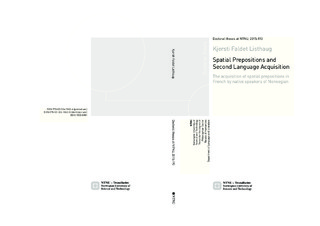| dc.contributor.author | Listhaug, Kjersti Faldet | |
| dc.date.accessioned | 2016-01-27T14:23:32Z | |
| dc.date.available | 2016-01-27T14:23:32Z | |
| dc.date.issued | 2015 | |
| dc.identifier.isbn | 978-82-326-1043-3 | |
| dc.identifier.issn | 1503-8181 | |
| dc.identifier.uri | http://hdl.handle.net/11250/2375058 | |
| dc.description.abstract | The overall objective of the present thesis was to investigate the semantic underpinnings of a selection of spatial prepositions in Norwegian and French, to assess sources of difficulties for the use and comprehension of such prepositions in an L2, and to investigate how knowledge of the meaning of spatial preposition in a second language changes with increasing proficiency. This was studied within the Functional Geometric Framework, FGF (Coventry & Garrod, 2004), which permits for a finegrained study of underlying semantic features relevant for spatial preposition usage; geometric routines, dynamic-kinematic routines and object knowledge. Data consisted of preposition production and acceptability judgments, and were collected from five participant groups: one L1 Norwegian group, one L1 French group, and three different L2 French groups.
An important finding in the present thesis is that geometric and functional information underlie comprehension prepositions in both Norwegian and French in similar ways to those theoretically studied by Vandeloise (1986) and to those established in a large body of experimental work for English prepositions. Despite some typological differences in the expression of space in Norwegian and French, native speakers of Norwegian and French make meaning distinctions based on geometry and function in analogous ways. Differences in preposition usage between the two languages stem primarily from language-specific ways of combining object labels and prepositions. Such combinations are sometimes arbitrary, and language conventions may override strong geometric or functional cues for preposition choice. The consequence of the findings for L1 Norwegian and L1 French is that Norwegian learners of L2 French should be able to rely on their intuitions about the semantics of preposition in Norwegian for a native-like comprehension of French prepositions. However, findings in the present thesis are that while L2 users with relatively high L2 proficiency are able to make native-like distinctions based on functional information for prepositions denoting location on the vertical axis, they differ from native speakers in the meaning-distinctions they make based on geometrical information. These findings are directly comparable to findings from a large study of the L2 acquisition of prepositions in English and Spanish (Coventry, Guijarro-Fuentes, & Valdés, 2011). It is therefore likely that the weighting of geometric information for the meaning of spatial prepositions in the L2 takes longer to readjust than the weighting of functional information, at least for prepositions denoting location on the vertical axis. Moreover, findings in the thesis are that both preposition production and judgments about the acceptability of preposition usage are more consistent in the L2 user groups with the highest L2 proficiency. This indicates that the semantic network for spatial prepositions undergoes structuring and tightening as proficiency in the L2 increases, and that lexical knowledge continues to develop in depth also after a preposition has entered into the L2 user’s productive vocabulary. | nb_NO |
| dc.language.iso | eng | nb_NO |
| dc.publisher | NTNU | nb_NO |
| dc.relation.ispartofseries | Doctoral thesis at NTNU;2015:193 | |
| dc.relation.haspart | Paper 1:
Listhaug, Kjersti Faldet.
Les prépositions spatiales en français et en norvégien: une étude expérimentale et comparative. Syntaxe & Sémantique 2014 ;Volum 15. s. 199-229
https://doi.org/10.3917/ss.015.nc
(http://hdl.handle.net/11250/2579046) | |
| dc.relation.haspart | Paper 2:
Listhaug, Kjersti Faldet.
Spatial prepositions in the L2:
Geometry vs. function/
Le rôle du niveau de maîtrise pour la représentation sémantique des prépositions spatiales en langue seconde. Synergies Pays Scandinaves 2018 (13) s. 79-89
http://gerflint.fr/Base/Paysscandinaves13/faldet_listhaug.pdf (https://ntnuopen.ntnu.no/ntnu-xmlui/handle/11250/2589058) | |
| dc.relation.haspart | Paper 3:
Listhaug, Kjersti Faldet
Spatial prepositions in the L2: Does proficiency have a role? | |
| dc.title | Spatial Prepositions and Second Language Acquisition: The acquisition of spatial prepositions in French by native speakers of Norwegian | nb_NO |
| dc.type | Doctoral thesis | nb_NO |
| dc.subject.nsi | VDP::Humanities: 000::Linguistics: 010 | nb_NO |
